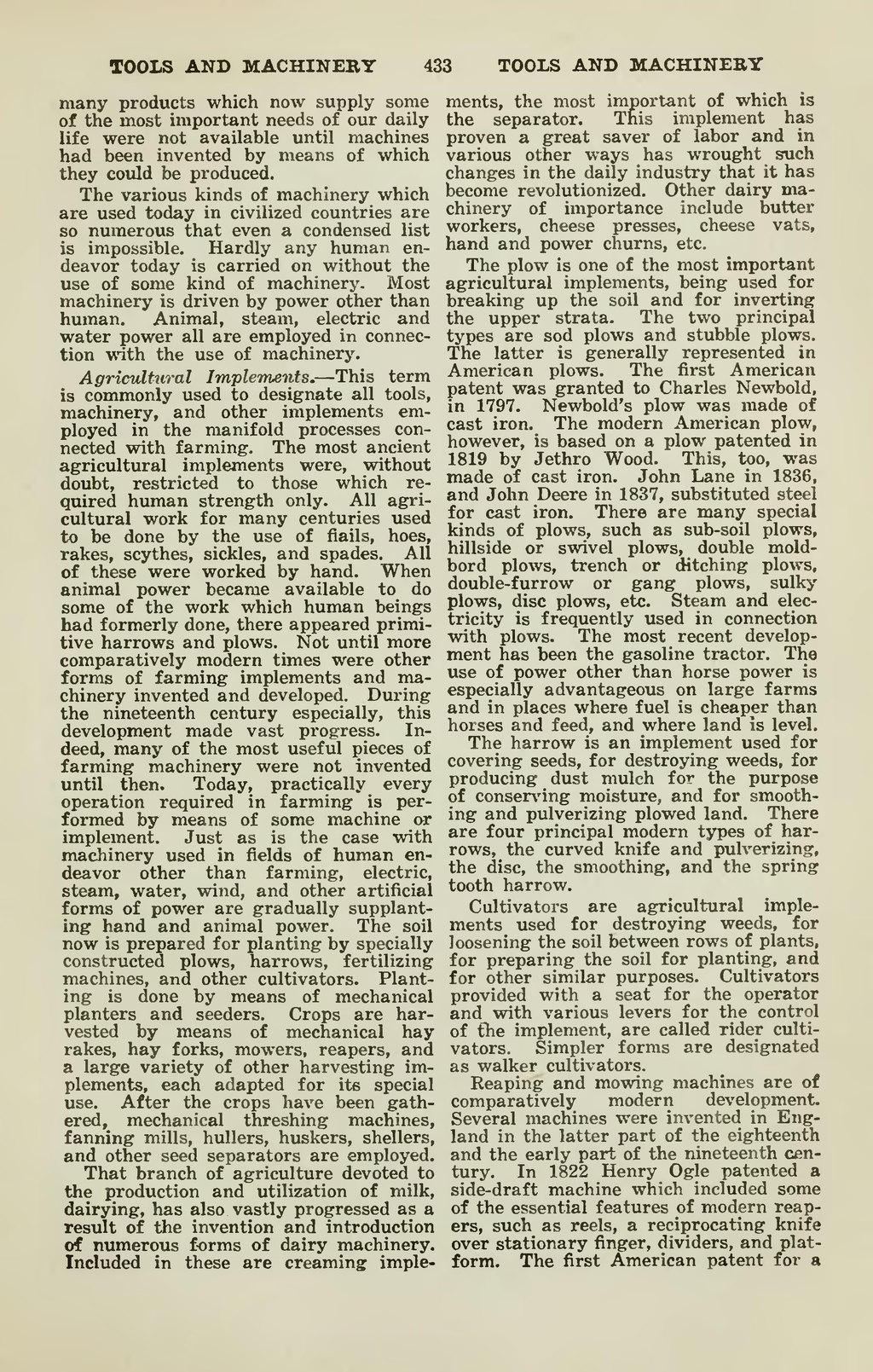TOOLS AND MACHINERY 433 TOOLS AND MACHINERY many products which now supply some of the most important needs of our daily life were not available until machines had been invented by means of which they could be produced. The various kinds of machinery which are used today in civilized countries are so numerous that even a condensed list is impossible. Hardly any human en- deavor today is carried on without the use of some kind of machinery. Most machinery is driven by power other than human. Animal, steam, electric and water power all are employed in connec- tion ■with the use of machinery. Agricultural Implements. — This term is commonly used to designate all tools, machinery, and other implements em- ployed in the manifold processes con- nected with farming. The most ancient agricultural implements were, without doubt, restricted to those which re- quired human strength only. All agri- cultural work for many centuries used to be done by the use of flails, hoes, rakes, scythes, sickles, and spades. All of these were worked by hand. When animal power became available to do some of the work which human beings had formerly done, there appeared primi- tive harrows and plows. Not until more comparatively modern times were other forms of farming implements and ma- chinery invented and developed. During the nineteenth century especially, this development made vast progress. In- deed, many of the most useful pieces of farming machinery were not invented until then. Today, practically every operation required in farming is per- formed by means of some machine or implement. Just as is the case with machinery used in fields of human en- deavor other than farming, electric, steam, water, wind, and other artificial forms of power are gradually supplant- ing hand and animal power. The soil now is prepared for planting by specially constructed plows, harrows, fertilizing machines, and other cultivators. Plant- ing is done by means of mechanical planters and seeders. Crops are har- vested by means of mechanical hay rakes, hay forks, mowers, reapers, and a large variety of other harvesting im- plements, each adapted for its special use. After the crops have been gath- ered, mechanical threshing machines, fanning mills, hullers, buskers, shellers, and other seed separators are employed. That branch of agriculture devoted to the production and utilization of milk, dairying, has also vastly progressed as a result of the invention and introduction of numerous forms of dairy machinery. Included in these are creaming imple- ments, the most important of which is the separator. This implement has proven a great saver of labor and in various other ways has wrought such changes in the daily industry that it has become revolutionized. Other dairy ma- chinery of importance include butter workers, cheese presses, cheese vats, hand and power churns, etc. The plow is one of the most important agricultural implements, being used for breaking up the soil and for inverting the upper strata. The two principal types are sod plows and stubble plows. The latter is generally represented in American plows. The first American patent was granted to Charles Newbold, in 1797. Newbold's plow was made of cast iron. The modern American plow, however, is based on a plow patented in 1819 by Jethro Wood. This, too, was made of cast iron. John Lane in 1836, and John Deere in 1837, substituted steel for cast iron. There are many special kinds of plows, such as sub-soil plows, hillside or swivel plows, double mold- bord plows, trench or ditching plows, double-furrow or gang plows, sulky plows, disc plows, etc. Steam and elec- tricity is frequently used in connection with plows. The most recent develop- ment has been the gasoline tractor. The use of power other than horse power is especially advantageous on large farms and in places where fuel is cheaper than horses and feed, and where land is level. The harrow is an implement used for covering seeds, for destroying weeds, for producing dust mulch for the purpose of conserving moisture, and for smooth- ing and pulverizing plowed land. There are four principal modern types of har- rows, the curved knife and pulverizing, the disc, the smoothing, and the spring tooth harrow. Cultivators are agricultural imple- ments used for destroying weeds, for loosening the soil between rows of plants, for preparing the soil for planting, and for other similar purposes. Cultivators provided with a seat for the operator and with various levers for the control of the implement, are called rider culti- vators. Simpler forms are designated as walker cultivators. Reaping and mowing machines are of comparatively modern development. Several machines were invented in Eng- land in the latter part of the eighteenth and the early part of the nineteenth cen- tury. In 1822 Henry Ogle patented a side-draft machine which included some of the essential features of modern reap- ers, such as reels, a reciprocating knife over stationary finger, dividers, and plat- form. The first American patent for a
Page:Collier's New Encyclopedia v. 09.djvu/495
This page needs to be proofread.
LEFT
433
RIGHT
